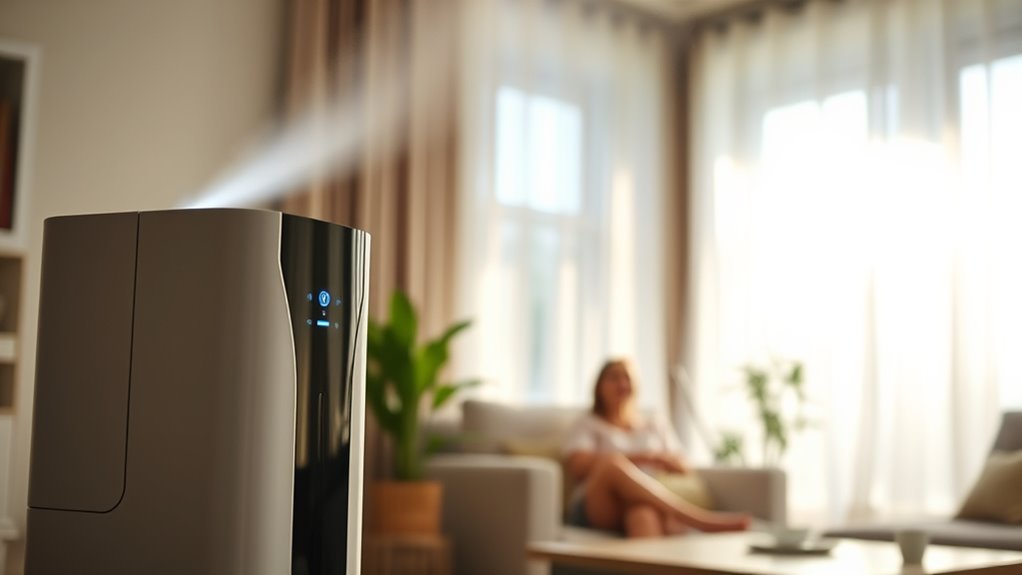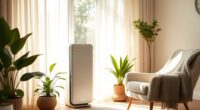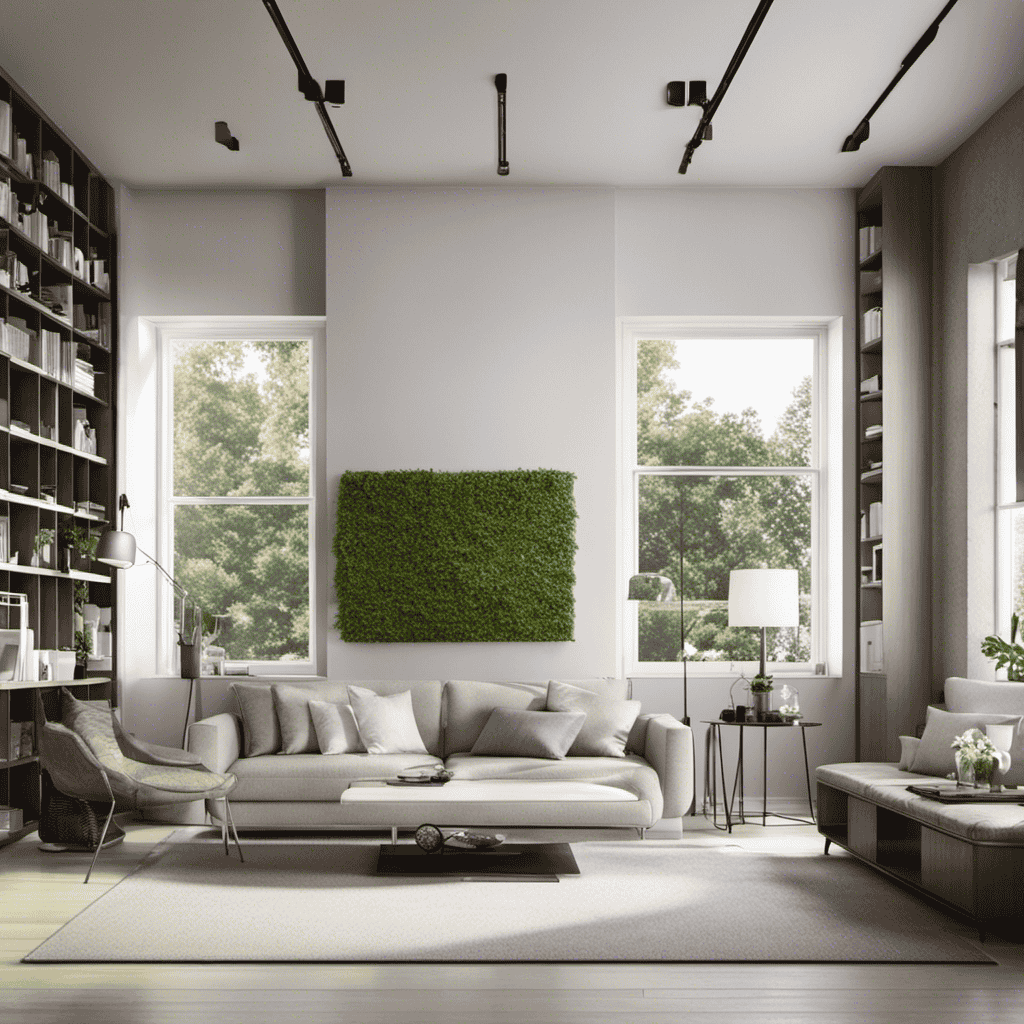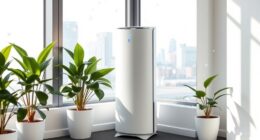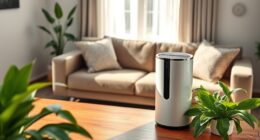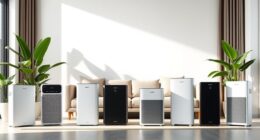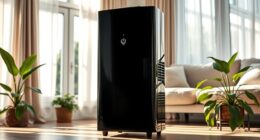Using an air purifier with a HEPA filter can markedly improve your indoor air quality, especially if you have COPD or respiratory issues. It helps remove airborne irritants like dust, pollen, pet dander, and bacteria, reducing inflammation and easing breathing difficulties. This can lead to fewer flare-ups, better sleep, and a more comfortable environment. To benefit fully, selecting the right device and maintaining it properly is essential—more tips to optimize your airflow and lung health await.
Key Takeaways
- HEPA air purifiers effectively remove airborne allergens, dust, and pollutants that worsen COPD symptoms.
- Using air purifiers can reduce airway inflammation and irritation, supporting better lung function.
- Improved indoor air quality from purifiers helps decrease COPD flare-ups and respiratory infections.
- Air purifiers create a healthier environment, making breathing easier and enhancing overall lung health.
- Regular use and maintenance of air purifiers contribute to symptom relief and improved quality of life for COPD patients.
Understanding COPD and Its Impact on Lung Function

Chronic Obstructive Pulmonary Disease (COPD) is a progressive lung condition that primarily affects your ability to breathe. It reduces your lung capacity, making it harder to take in enough air with each breath. This happens because airway inflammation causes your airways to become swollen and narrowed, restricting airflow. As inflammation persists, the walls of your airways and alveoli (air sacs) break down, further decreasing lung function. You might notice increased shortness of breath, especially during physical activity. COPD’s impact on lung capacity means you can’t exchange oxygen and carbon dioxide efficiently, leading to fatigue and breathing difficulties. Understanding these changes helps you recognize how COPD gradually impairs your respiratory health, emphasizing the importance of managing airway inflammation to preserve lung function. Continuous monitoring of air quality can help develop new strategies to manage and predict disease progression effectively.
How Indoor Air Quality Affects Respiratory Health
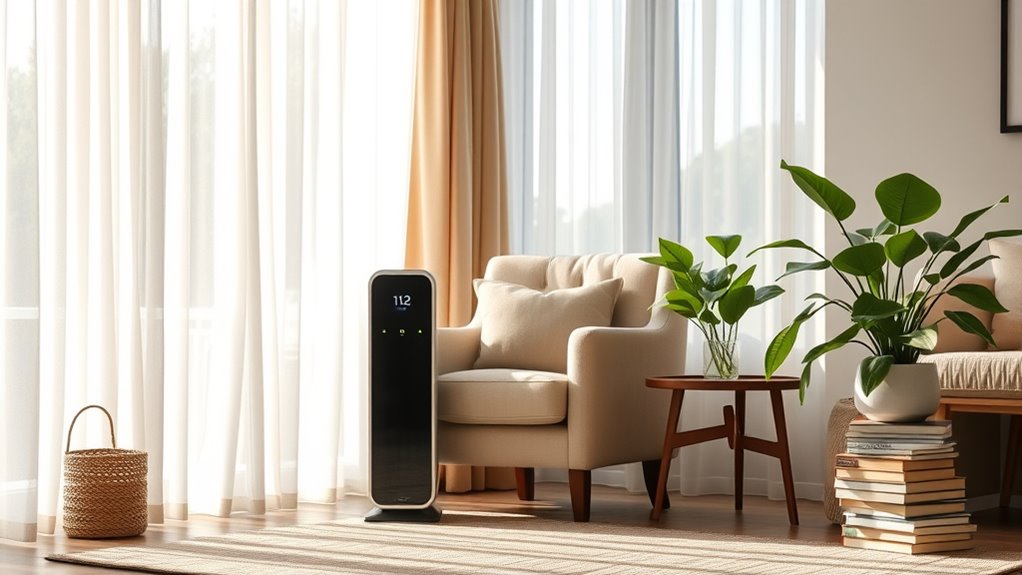
Since inflammation and airway narrowing are key factors in COPD, keeping the air you breathe indoors as clean as possible can make a significant difference. Indoor pollution and airborne allergens can worsen your symptoms by irritating your airways and increasing inflammation. Common sources include dust, pet dander, mold, and tobacco smoke, all of which can trigger coughing, wheezing, and shortness of breath. Poor indoor air quality creates a hostile environment for your lungs, especially if you already have respiratory issues. By reducing airborne allergens and indoor pollutants, you help minimize inflammation and airway constriction. Using air purifiers with HEPA filters can effectively trap many airborne particles, further improving indoor air quality. Implementing smart air quality monitors can help you track and manage indoor pollution levels more effectively. Additionally, choosing devices with HEPA filtration can provide enhanced removal of fine particles that aggravate respiratory conditions. Regularly replacing filters and maintaining your air purifier ensures it functions at peak performance, which is crucial for lung health over time. Ensuring clean indoor air is a crucial step in managing COPD symptoms and protecting your lung health over time.
Types of Air Purifiers Suitable for COPD Patients
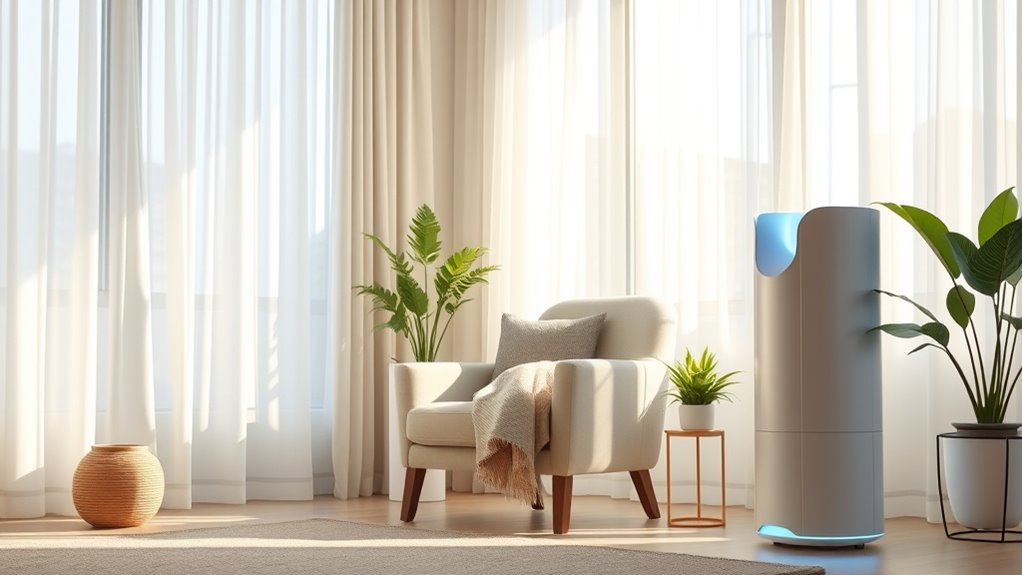
Choosing the right air purifier can make a big difference for your lung health. HEPA filters are highly effective at capturing small particles that irritate your airways. You’ll need to decide between portable units for specific rooms or whole-house systems for extensive coverage. Regular maintenance and timely filter replacements are essential to ensure optimal performance and consistent air quality maintenance and cleaning. Additionally, selecting an air purifier with features like air filter efficiency can enhance its ability to improve indoor air quality and benefit your respiratory health. Incorporating digital literacy into your routine can also help you better understand and utilize air purifiers for optimal health benefits. Understanding air quality standards can further assist in choosing the most suitable device for your needs.
HEPA Filter Effectiveness
HEPA filters are highly effective for COPD patients because they capture over 99.97% of airborne particles, including dust, pollen, pet dander, and bacteria. This makes HEPA filtration essential for improving indoor air quality and reducing respiratory irritation. When choosing an air purifier, look for models that prioritize particle capture through HEPA filtration. Additionally, some modern toilets incorporate dual-flush systems that promote water efficiency and reduce overall water consumption, benefiting both the environment and utility costs. Incorporating air purification technology can further optimize respiratory health by continuously cleansing the indoor environment. Modern filtering technologies are advancing the effectiveness of air purifiers, ensuring cleaner air for sensitive individuals. As automation in business operations advances, integrating air purification systems can improve workplace air quality and employee well-being. For optimal performance, selecting devices with high-efficiency filters ensures maximum removal of harmful particles. Here are four reasons HEPA filters are a top choice: 1. Superior particle removal efficiency 2. Reduces allergens and irritants 3. Enhances breathing comfort 4. Supports overall lung health.
Portable vs. Whole-House
When considering how to improve indoor air quality for COPD patients, understanding the different types of air purifiers available can make a significant difference. Portable air purifiers are compact, affordable, and easy to move between rooms, making them ideal for targeted use. They often have lower upfront costs but may require multiple units for full coverage. Whole-house systems, on the other hand, integrate with your HVAC and provide consistent air purification throughout your home. However, they tend to have higher installation challenges and costs. When comparing these options, consider your budget, space, and convenience. Portable units offer flexibility and lower initial investment, while whole-house systems deliver extensive coverage but involve more complex installation. Choose what best fits your needs for cleaner, healthier indoor air. Understanding air purifier types can help you make an informed decision tailored to your specific respiratory health needs. Additionally, selecting an air purifier with HEPA filters ensures effective removal of airborne particles, which is particularly beneficial for those with respiratory conditions. It’s also important to recognize that air quality monitoring can assist in determining when to replace filters or upgrade your system for optimal health benefits, especially since air filtration efficacy varies based on device specifications and maintenance.
How Air Purifiers Help Reduce Airborne Irritants and Pollutants
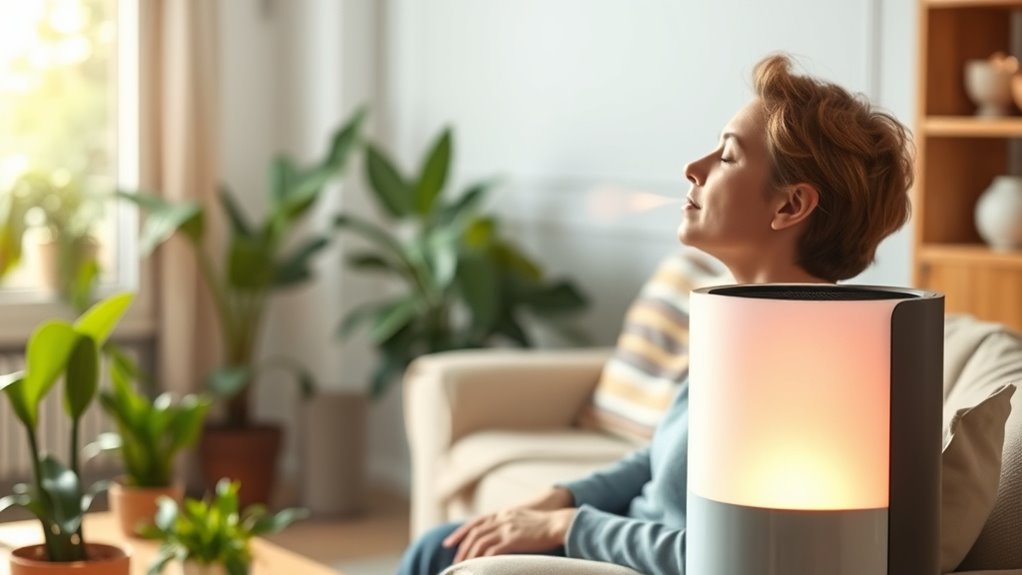
Air purifiers actively remove airborne irritants and pollutants, making the air you breathe cleaner and safer. They target common indoor pollutants, including airborne allergens that can worsen respiratory conditions. Here are four ways they help:
- Capture airborne allergens like pollen, pet dander, and dust mites
- Remove indoor pollutants such as smoke, VOCs, and chemical fumes
- Reduce mold spores that trigger breathing problems
- Improve overall air quality, easing COPD symptoms and respiratory discomfort
An added benefit is their ability to utilize HEPA filters, which are highly effective in capturing tiny particles and enhancing indoor air purity. Using air purification technology can further enhance the removal of pollutants and improve respiratory health. Incorporating smart features like real-time air quality monitoring can help maintain optimal indoor conditions and alert you when filter replacements are needed. Additionally, proper filter maintenance ensures the consistent performance of your air purifier, maximizing its health benefits.
The Role of HEPA Filters in Capturing Harmful Particles
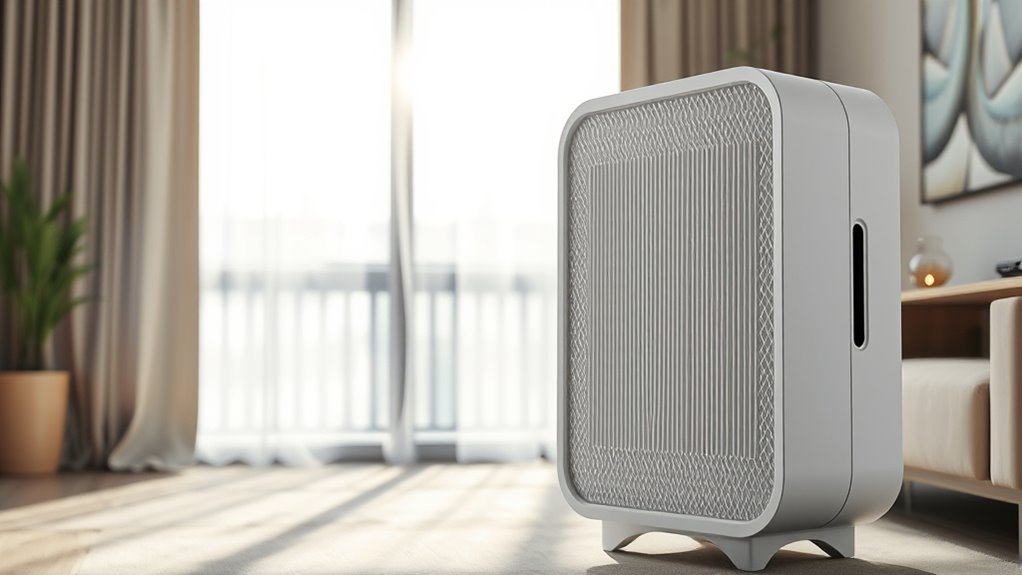
Because harmful particles can easily circulate indoors, high-efficiency particulate air (HEPA) filters play a crucial role in capturing these tiny, airborne threats. Their advanced filter technology traps particles as small as 0.3 microns, including dust, pollen, pet dander, and microscopic pollutants. This makes them essential for air purification, especially if you have respiratory conditions like COPD. HEPA filters work by forcing air through dense fibers that trap harmful particles, preventing them from recirculating in your living space. Their efficiency helps improve indoor air quality, reducing the risk of irritation and inflammation of your lungs. Additionally, proper maintenance and filter replacement are vital to ensure optimal performance of HEPA filters. Regularly cleaning and replacing filters can significantly enhance their effectiveness in capturing airborne irritants. Many experts recommend a routine filter check to maintain peak filtration capacity. By effectively capturing airborne irritants, HEPA filters support healthier lung function and create a safer environment for respiratory health. Quotes about protective measures highlight the importance of maintaining clean air for overall well-being.
Benefits of Using Air Purifiers for Symptom Relief and Disease Management
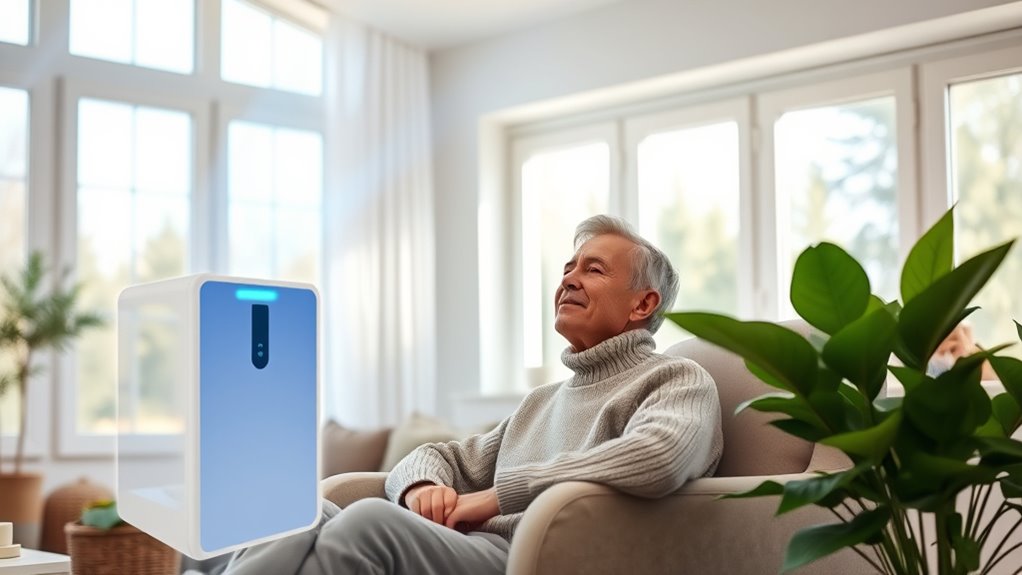
Using an air purifier can considerably improve your indoor air quality, making it easier to breathe. It helps reduce respiratory irritants like dust, pollen, and smoke that can worsen symptoms. With cleaner air, you may experience better symptom management and overall lung health. Incorporating a cozy bedroom ambiance can further enhance comfort and promote relaxation, which is beneficial for respiratory health. Additionally, understanding the tax implications of gold IRAs can help you make informed financial decisions that support your overall well-being.
Improved Air Quality
Have you ever considered how cleaner indoor air can considerably ease your breathing? Air purifiers improve air quality by reducing indoor pollution, making it easier to breathe and manage symptoms. With advanced air filter technology, they trap dust, allergens, and airborne irritants. Here are four benefits:
- Reduces indoor pollution levels
- Minimizes airborne irritants
- Enhances overall lung health
- Creates a healthier living environment
Reduced Respiratory Irritants
Cleaner indoor air not only improves overall lung health but also directly reduces respiratory irritants that can trigger symptoms or worsen chronic conditions. Air purifiers help remove airborne allergens like pollen, pet dander, and mold spores, which are common irritants for those with COPD. They also assist in dust suppression, capturing fine dust particles that can settle in your lungs and cause inflammation. By filtering out these irritants, air purifiers create a healthier environment and lessen the frequency of flare-ups. This reduction in airborne allergens and dust helps you breathe more easily and minimizes irritation, making daily life more manageable. With cleaner air, your respiratory system faces less stress, supporting better disease management and symptom relief.
Enhanced Symptom Management
Air purifiers can substantially improve your ability to manage COPD symptoms by reducing airborne irritants that trigger flare-ups. Advanced air purifier technology helps filter out dust, pollen, pet dander, and other pollutants, providing a cleaner environment for respiratory therapy. This creates a calmer setting, making symptom relief more effective.
Here are four ways air purifiers support enhanced symptom management:
- Minimize coughing and wheezing triggers
- Improve airflow during respiratory therapy sessions
- Reduce mucus buildup and chest congestion
- Decrease exposure to airborne allergens and pollutants
Tips for Choosing the Right Air Purifier for Your Home
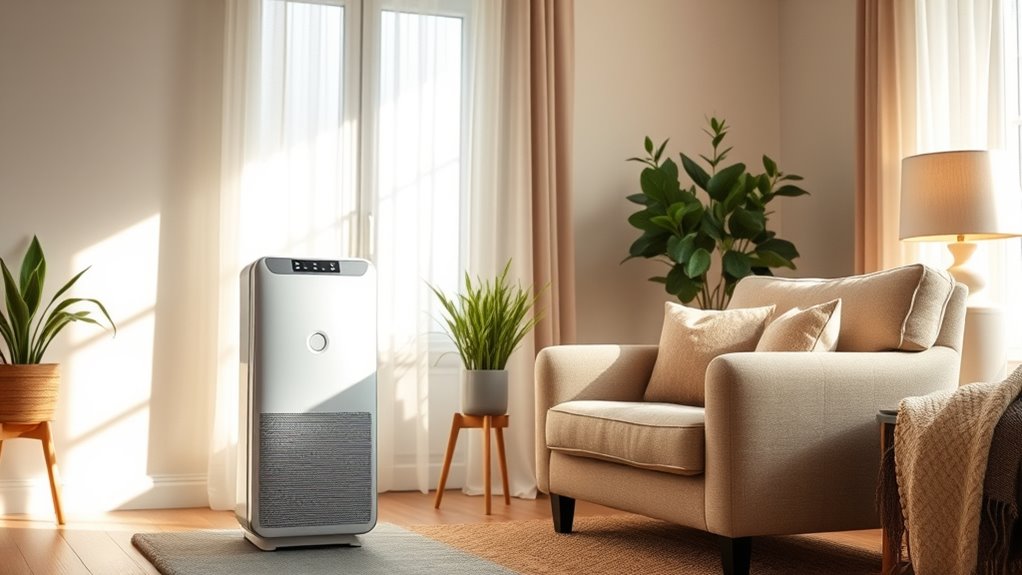
Choosing the right air purifier for your home can considerably improve indoor air quality, especially if you or someone in your household has respiratory issues like COPD. Look for models that feature advanced air purifier technology, such as HEPA filters, which effectively capture airborne particles. Air quality sensors are also essential, as they monitor pollution levels in real-time and adjust the purifier’s operation accordingly, ensuring peak performance without wasting energy. Consider the size of the space you want to purify; a larger room may require a more powerful unit. Also, check for user-friendly features like auto mode and filter indicators. By selecting an air purifier with these features, you’ll better manage indoor pollutants and create a healthier living environment.
Proper Placement and Maintenance of Air Purifiers
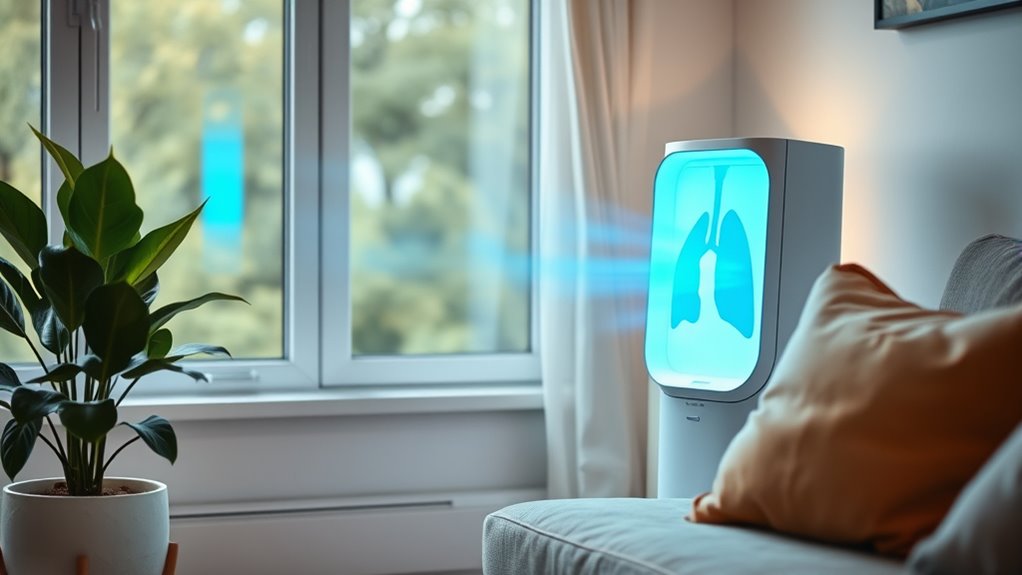
To get the most benefit from your air purifier, place it in a central location away from walls and obstructions. Make sure to follow regular maintenance routines, like changing filters on schedule, to keep it running efficiently. Proper placement and upkeep are key to improving your lung health and reducing airborne irritants.
Optimal Placement Strategies
Proper placement and regular maintenance are essential to guarantee your air purifier effectively improves lung health. To optimize air circulation, position your device in a central location away from walls and furniture that block airflow. Keep it at least a few feet from windows or vents to prevent outside pollutants from bypassing the filter. Consider these strategies:
- Place the purifier in frequently used rooms for maximum benefit.
- Avoid corners; position it where air flows freely.
- Elevate the device if possible, to improve air circulation.
- Regularly check and clean the device placement area to prevent dust buildup.
Regular Maintenance Routines
Regular maintenance is essential to guarantee your air purifier functions effectively and continues to improve your lung health. You should follow a consistent cleaning schedule, wiping down external surfaces and vacuuming filters if applicable. Regularly check the filters and replace them as recommended by the manufacturer—typically every 3 to 6 months—to ensure ideal air quality. Neglecting filter replacement can reduce the purifier’s efficiency and allow pollutants to circulate. Keep an eye on indicator lights that signal when filters need changing. Additionally, clean the pre-filters frequently to extend the life of the main filters. Proper maintenance not only maximizes the purifier’s performance but also prolongs its lifespan, helping you breathe easier and supporting your respiratory health.
Additional Strategies for Improving Indoor Air Quality
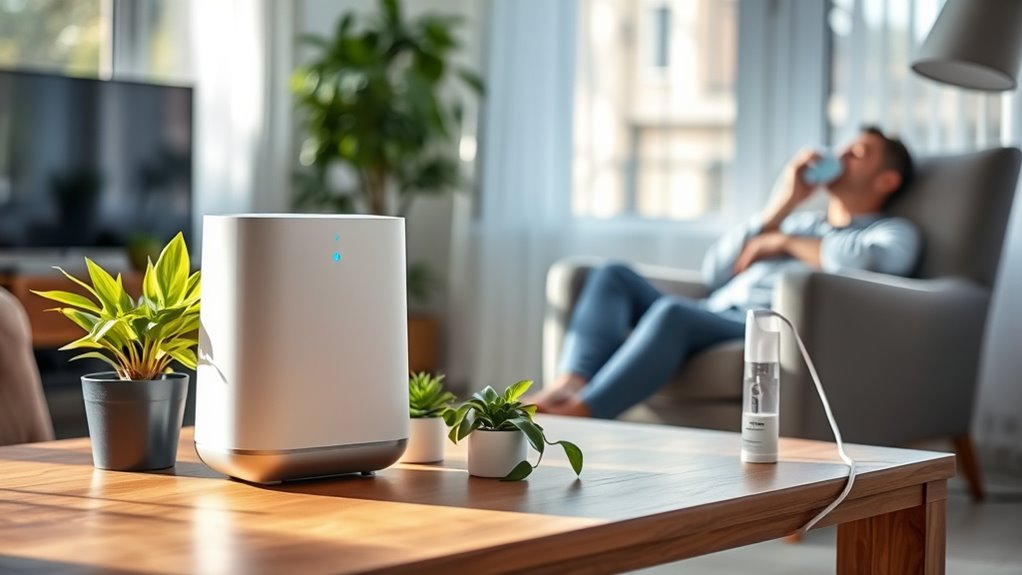
Improving indoor air quality is essential for managing COPD and protecting lung health, especially since you spend much of your time indoors. You can enhance air quality by focusing on these strategies:
Enhance your lung health by improving indoor air quality with simple, effective strategies.
- Maximize indoor air circulation by opening windows regularly to refresh the air.
- Use exhaust fans in kitchens and bathrooms to reduce moisture and pollutants.
- Reduce allergens by frequently cleaning surfaces and vacuuming with HEPA filters.
- Keep humidity levels between 30-50% to prevent mold growth and dust mites.
These steps help lower airborne irritants and improve allergen reduction. Good indoor air circulation ensures fresh air flows through your space, while minimizing irritants supports easier breathing. Incorporating these strategies creates a healthier environment for your lungs.
Real-Life Experiences and Testimonials From COPD Patients Using Air Purifiers
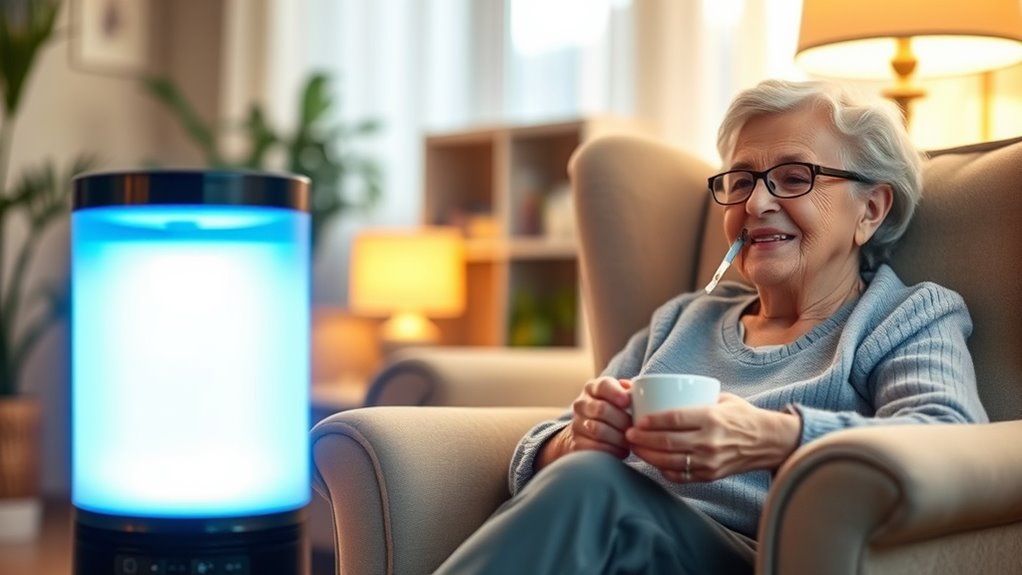
Many COPD patients have found that using air purifiers markedly enhances their breathing comfort at home. They often share that, despite common air purifier myths suggesting they’re too expensive or ineffective, the real benefits outweigh the cost considerations. These devices help reduce allergens, dust, and pollutants that trigger symptoms, making daily life more manageable. Patients report feeling less short of breath and experiencing fewer flare-ups. Some initially hesitated due to misconceptions about maintenance and cost, but they’ve discovered that investing in a quality air purifier is affordable and worthwhile. Testimonials highlight improved sleep and overall well-being, reinforcing that clearing indoor air can substantially impact respiratory health. If you’re considering one, know that many find it a valuable addition to their COPD management plan.
Frequently Asked Questions
Can Air Purifiers Completely Eliminate All COPD Triggers Indoors?
You might hope air purifiers can completely eliminate all triggers indoors, but they can’t. While they considerably improve indoor air quality and help reduce common triggers like dust, pet dander, and smoke, some particles and allergens may still linger. To maximize trigger reduction, combine air purifiers with good ventilation and regular cleaning. Keep realistic expectations, as no device can fully eliminate every indoor trigger, but they do make a noticeable difference.
How Often Should HEPA Filters Be Replaced for Optimal Performance?
Did you know that HEPA filters typically last 6 to 12 months? For maximum performance, you should follow the manufacturer’s recommended maintenance schedule and check the filter’s condition regularly. Keep in mind, the filter lifespan depends on usage and air quality. Replacing your HEPA filter on time ensures it continues to capture harmful particles effectively, helping to keep your indoor air clean and healthy.
Are There Specific Air Purifier Features Recommended for Severe COPD Cases?
You should look for air purifiers with advanced HEPA filtration and features designed to improve air quality for severe cases. Opt for models with higher CADR ratings, multiple fan speeds, and real-time air quality sensors. These features help remove fine particles and pollutants effectively. For best results, choose an air purifier that adapts to your environment, ensuring cleaner air and better respiratory health in challenging conditions.
Do Air Purifiers Help With Other Respiratory Conditions Beyond COPD?
You might wonder if air purifiers help with other respiratory conditions. The answer is yes. They reduce indoor allergens, which can trigger asthma or allergies, and improve air quality monitoring, ensuring cleaner air. By capturing dust, pet dander, and pollen, air purifiers support better breathing for those with various respiratory issues. Regular use helps create a healthier environment, easing symptoms and promoting lung health beyond just COPD.
What Are Potential Risks of Using Air Purifiers Incorrectly at Home?
Using air purifiers incorrectly can pose risks to your indoor air quality. If you neglect regular air purifier maintenance, such as changing filters, it can reduce effectiveness or even circulate dust and allergens. Poor maintenance can lead to mold growth or bacterial buildup. To stay safe, guarantee proper usage, follow manufacturer instructions, and keep your device clean. This way, you maintain healthy indoor air quality and avoid potential health hazards.
Conclusion
Think of an air purifier as a gust of fresh mountain air in your home. By reducing airborne irritants and improving indoor air quality, it can make your COPD symptoms easier to manage. When you choose the right purifier and keep it well-maintained, you’re giving your lungs a cleaner environment to thrive in. Breathe easier knowing you’re taking proactive steps—it’s like turning on a gentle breeze that clears away the fog and lifts your spirits.
